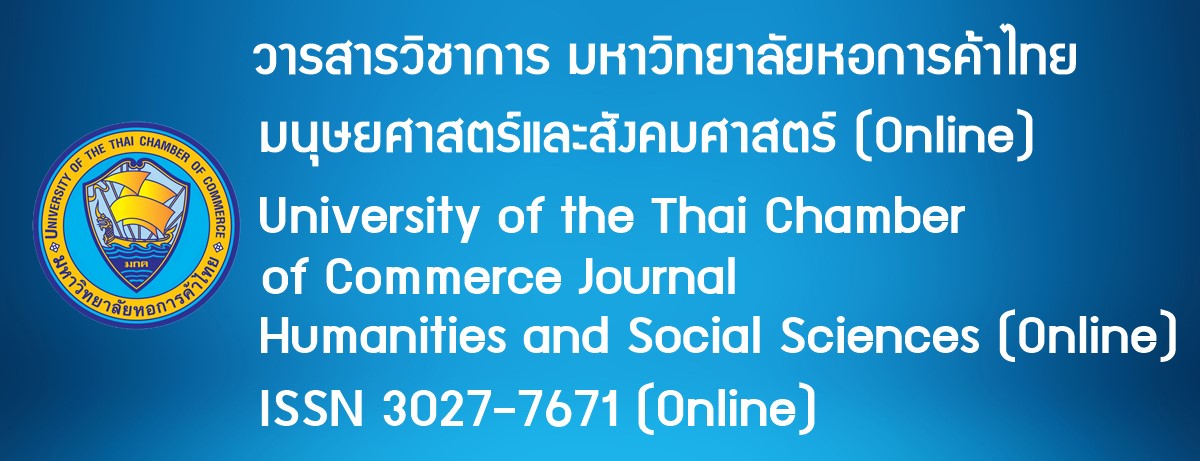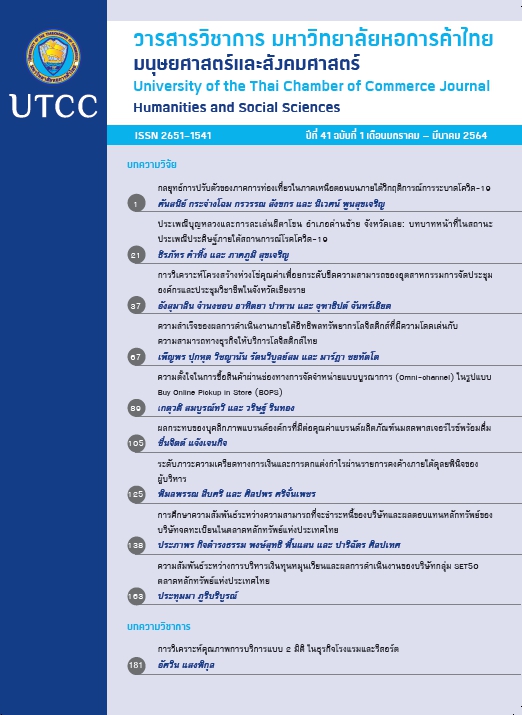ความสำเร็จ ความสำเร็จของผลการดำเนินงานภายใต้อิทธิพลทรัพยากรโลจิสติกส์ที่มีความโดดเด่นกับความสามารถทางธุรกิจให้บริการโลจิสติกส์ไทย
Main Article Content
บทคัดย่อ
ผู้ให้บริการโลจิสติกส์ในประเทศไทยเป็นกลุ่มธุรกิจขนาดเล็ก มีทักษะและเข้าใจเฉพาะกลุ่มงานบริการ
เข้าถึงแหล่งเงินทุนต้นทุนต่ำได้ยาก ทำให้ขาดโอกาสขยายธุรกิจและมีความสามารถในการแข่งขันต่ำเนื่องจากไม่มี
ความร่วมมือระหว่างธุรกิจที่ต่อเนื่อง ส่งผลให้ผู้ประกอบการมีอำนาจการต่อรองต่ำและต้องเผชิญกับความรุนแรง
ทางด้านราคาบริการของบริษัทขนาดใหญ่หรือบริษัทข้ามชาติ จึงทำให้บทความนี้มีวัตถุประสงค์เพื่อสร้างโมเดล
สมการโครงสร้างเชิงความสำเร็จของผลการดำเนินงาน นำมากำหนดเส้นทางการพัฒนาและเพิ่มประสิทธิภาพ
การบริหารจัดการธุรกิจ โดยทบทวนวรรณกรรมที่เกี่ยวกับทฤษฎีฐานทรัพยากร และอาศัยระเบียบวิธีวิจัยแบบ
ผสมผสานเริ่มต้นจากการวิจัยเชิงปริมาณและวิธีเชิงคุณภาพ มีการรวบรวมข้อมูลด้วยแบบสอบถามและแบบ
สัมภาษณ์กึ่งโครงสร้างที่ผ่านเกณฑ์ทดสอบเครื่องมือการวิจัย ใช้แบบสอบถามความคิดจากสถานประกอบการ
ที่มีกำไรสุทธิในปี 2560 ตามลำดับ ผลการวิจัย พบว่า ผู้ให้บริการโลจิสติกส์มีวิธีขยายธุรกิจให้เติบโต จำเป็นต้องมี
การปรับปรุงคุณภาพและพัฒนาระบบบริหารงานอย่างต่อเนื่อง โดยเฉพาะด้านความสามารถในการให้บริการ
โลจิสติกส์ ซึ่งเป็นการบริหารงานแบบองค์รวม ทำให้เกิดการเชื่อมโยงกระบวนการทำงานในองค์กร ให้สอดคล้อง
กับระบบงานของผู้มีส่วนได้เสียภายนอกเป็นมาตรฐานเดียวกัน อีกทั้งได้รับแรงสนับสนุนและความพร้อมของ
ทรัพยากรโลจิสติกส์ที่มีความโดดเด่นที่สอดรับกับการปฏิบัติงาน เพื่อสร้างมูลค่าเพิ่มให้แก่องค์กร และมีส่วน
ช่วยให้บุคลากรในองค์กรสามารถมีศักยภาพการทำงานได้อย่างมีประสิทธิภาพ
Article Details

This work is licensed under a Creative Commons Attribution-NonCommercial-NoDerivatives 4.0 International License.
ลิขสิทธิ์ของบทความ
ผลงานที่ได้รับการตีพิมพ์ถือเป็นลิขสิทธิ์ของมหาวิทยาลัยหอการค้าไทย ห้ามมิให้นำเนื้อหา ทัศนะ หรือข้อคิดเห็นใด ๆ ของผลงานไปทำซ้ำ ดัดแปลง หรือเผยแพร่ ไม่ว่าทั้งหมดหรือบางส่วนโดยไม่ได้รับอนุญาตเป็นลายลักษณ์อักษรจากมหาวิทยาลัยหอการค้าไทยก่อน
References
กรมเจรจาการค้าระหว่างประเทศ. (2556). รายงานฉบับสมบูรณ์โครงการศึกษาวิจัยโอกาส ผลกระทบ และมาตรการรองรับสำหรับธุรกิจให้บริการโลจิสติกส์ไทยจากการจัดทำเขตการค้าเสรี พฤษภาคม 2556. สืบค้นเมื่อ 6 พฤศจิกายน 2560, จาก http://www.thaifta.com/thaifta/Home/รายงานการศึกษา/tabid/55/ctl/Details/mid/435/ItemID/7923/Default.aspx
กรมพัฒนาธุรกิจการค้า. (2559). เกณฑ์มาตรฐานคุณภาพการบริหารจัดการธุรกิจให้บริการโลจิสติกส์และเกณฑ์มาตรฐานคุณภาพการบริหารจัดการธุรกิจขนส่งสินค้าทางถนน ปี พ.ศ. 2558. สืบค้นเมื่อ 26 เมษายน 2561, จาก http://www.dbd.go.th/more_news.php?cid=869
กรมพัฒนาธุรกิจการค้า. (2561). คู่มือการพัฒนาระบบบริหารคุณภาพตามมาตรฐานสากล ISO 9001 สำหรับธุรกิจให้บริการโลจิสติกส์. สืบค้นเมื่อ 26 เมษายน 2561, จาก https://www.dbd.go.th/download/article/article_20190704132751.pdf
กรมพัฒนาธุรกิจการค้า. (2563). แหล่งค้นหาข้อมูลนิติบุคคลและประเภทธุรกิจในประเทศไทย. สืบค้น
เมื่อ 26 เมษายน 2561, จาก https://datawarehouse.dbd.go.th/index
ธนุตร์ เอี่ยมอร่าม. (2556). ทฤษฎีพื้นฐานของทรัพยากร: แหล่งกำเนิดความได้เปรียบในการแข่งขันอย่างยั่งยืนของผู้ประกอบการ SMEs. วารสารวิชาการ มหาวิทยาลัยหอการค้าไทย, 33(ฉบับพิเศษ), 302-316.
สำนักงานคณะกรรมการพัฒนาการเศรษฐกิจและสังคมแห่งชาติ. (2560). รายงานโลจิสติกส์ของประเทศไทยประจำปี 2559. สืบค้นเมื่อ 20 ตุลาคม 2560, จาก
https://www.nesdc.go.th/ewt_dl_link.php?nid=8119
สำนักงานคณะกรรมการพัฒนาการเศรษฐกิจและสังคมแห่งชาติ. (2561). GDP ไตรมาสที่สี่ ทั้งปี 2560
และแนวโน้มปี 2561. สืบค้นเมื่อ 26 เมษายน 2561, จาก http://www.nesdb.go.th/ewt_dl_link.php?nid=5165
สุภมาส อังศุโชติ, สมถวิล วิจิตรวรรณา, และรัชนีกูล ภิญโญภานุวัฒน์. (2554). สถิติวิเคราะห์สำหรับการวิจัยทางสังคมศาสตร์และพฤติกรรมศาสตร์: เทคนิคการใช้โปรแกรม LISREL (พิมพ์ครั้งที่ 3). กรุงเทพฯ: เจริญดีมั่นคงการพิมพ์.
Barney, J. B., & Clark, D. N. (2007). Resource‐based theory: Creating and sustaining competitive advantage. Oxford, England: Oxford University Press.
Darkow, I. L., Weidmann, M., & Lorentz, H. (2015). Adaptation of foreign logistics service providers' resources and capabilities to a new institutional environment. Retrieved July 9, 2017, from https://ideas.repec.org/a/bla/jscmgt/v51y2015i1p27-51.html
Hair, J. F., Black, W. C., Babin, B. J., & Anderson, R. E. (2010). Multivariate data analysis (7thed.). Upper Saddle River, NJ: Pearson Prentice Hall.
Karia, N., Wong, C. Y., Asaari, M. H. A. H., & Lai, K. (2015). The effects of resource bundling on third-party logistics providers’ performance. International Journal of Engineering Business Management, 7(9), 1-14.
Kuo, S. Y., Lin, P. C., & Lu, C. S. (2017). The effects of dynamic capabilities, service capabilities, competitive advantage, and organizational performance in container shipping. Transportation Research Part A: Policy and Practice, 95, 356–371.
Lavie, D. (2006). The competitive advantage of interconnected firms: An extension of the resource-based view. The Academy of Management Review, 31(3), 638–658.
Mandal, S., & Korasiga, V. R. (2016). An integrated-empirical logistics perspective on supply chain innovation and performance. Business: Theory and Practice, 17(1), 32–45.
Ralston, P. M., Grawe, S. J., & Daugherty, P. T. (2013). Logistics salience impact on logistics capabilities and performance. The International Journal of Logistics Management, 24(2), 136-152.
Rodrigo, M. R., Virginia, F. P., & Encarnación, G. S. (2016). Encouraging organization performance through the influence on technological distinctive competence on component of corporate entrepreneurship. International Entrepreneurship and Management Journal, 13(2), 397-426.
Samira, S., Mohammadreza, D. E., & Navid, N. (2013). Explain the theory of competitive advantage and comparison with industries based on advanced technology. International Journal of Economy, Management and Social Sciences, 2(10), 841-84.
Selviaridis, K., & Spring, M. (2007). Third party logistics: A literature review and research agenda. The International Journal of Logistics Management, 18(1), 125-150.
Wang, H. L. (2014). Theories for competitive advantage. Retrieved July 9, 2017, from https://ro.uow.edu.au/buspapers/408/
Wang, M., Jie, F., & Abareshi, A. (2015). Evaluating logistics capability for mitigation of supply chain uncertainty and risk in the Australian courier firms. Asia Pacific Journal of Marketing and Logistics, 27(3), 486-498.
Wheelen, T. L., & Hunger, J. D. (2010). Strategy management and business policy: Achieving sustainability. Upper Saddle River, NJ: Pearson Prentice Hall.
Yorulmaz, M., & Birgün, S. (2017). Maritime transport logistics service capabilities impact on customer service and financial performance: An application in the Turkish maritime sector. Journal of Business Research Turk, 3(9), 468-486.
Zacharia, Z. G., & Mentzer, J. T. (2004). Logistics salience in a changing environment. Journal of Business Logistics, 25(1), 187-210.
Zacharia, Z. G., & Mentzer, J. T. (2007). The role of logistics in new product development. Journal of Business Logistics, 28(1), 83-110.

